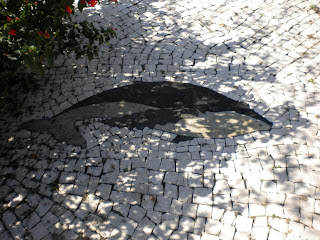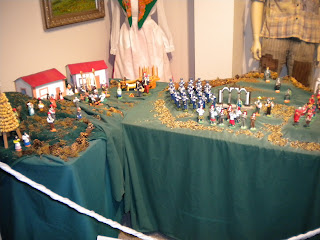For this blog, I decided to visit the Portuguese Historical Museum in San Jose. Honestly, this place was kind of creepy. It’s located within Kelley Park, which at one end features Happy Hallow Zoo and a Japanese garden. The end with the Portuguese Historical Museum is kind of a small town recreation. There is a trolley car, an old-fashioned gas station, and main street with several other streets splitting off of it, all with historical homes that were either recreated or picked up and moved to the site. When I went there, it was the weekend before Halloween, and walking down the main street definitely gave off a Children of the Corn vibe.
The Portuguese Historical Museum was located on the first little street off of the main street and was designed to look like the first permanent imperio in San Jose (a religious and cultural center). Outside of the museum, there are several interesting pieces of art in the stone walkway leading up to the entrance. First, there are two whales on either side of the center walkway, commemorating the centrality of the whaling industry in Portuguese culture until the early 1900s.
There is also a ship, which commemorates the rich maritime heritage of the Portuguese, which also kicked off the age of exploration in Europe.
In the center walkway is a recreation of a compass rose found in Lisbon Portugal. In the middle of the compass there is a map of the world with Europe as the center.
Lastly, before the steps leading up to the entrance, there is a recreation of the emblem found on the Portuguese flag
(mega-flags.com)
Inside the museum was amazing! All the work and research was really thorough and included information not only about Azoreans, but also about those from mainland Portugal, Madeira, and even those who went from the Azores, Madeira, and Portugal straight to Hawaii, something many people overlook in Portuguese immigration. The ground floor of the museum is a permanent collection, while the basement features rotating exhibits. On the first floor, the first section you will find when you walk in and go to the right (its kind of a big circle), is a short bit about life in the “old country”. One problem with the museum was that it often didn’t distinguish between mainland Portugal, the Azores, and Madeira and just lumped them all together as the old country. However, one of the many plaques of writing and pictures on the walls of the museum does note that many of the Portuguese in California immigrated (or their relatives immigrated) from the Azores or Madeira.
There is a plaque with photos of life in the old country, featuring typical architecture and livelihoods. The next section is about the trip to America, and features a very common painting of immigrants waiting to come to America.
The next plaque talks about the waves of Portuguese immigration to America, particularly the East Coast, California, and Hawaii. The first wave was in the 1800s and spurned by the whaling industry along the East Coast and California, and also by the Gold Rush in the mid-1800s. The second wave of Portuguese immigration occurred in the early 1900s and was due to political unrest in Portugal. The third wave of migration was spurned by the volcanic eruption in 1957 of an undersea volcano and ensuing earthquakes, which destroyed many villages across the Azores. This wave started with the Azorean Refugee Act in 1958 and 1960 and ended in the 80s, after a political revolution ousted the dictatorship in Portugal and established a democracy.
The next area featured a recreation of a Portuguese church. Unfortunately, when I went to the museum, I forgot my notebook at home so I didn’t take any notes, and I didn’t take a picture of the plaque, which said who donated the recreation and where the original was. However, based on the architecture, I’d make an educated guess and say the original is in a larger town, because there is a lot more to this than just the chapel.
Next was an area dedicated to the festa queens. There were several different capes and some pictures of past queens. The first cape was a long, red, and very sparkly and from 2007.
The next cape was a baby blue color, with some roses along the upper back and what looks like lace along the edges and in a bow at the bottom of the cape. This cape was from the 1920s.
Last, there was a plain white cape (not sure if it was plain, I'm just guessing since the back of the cape was turned away from where viewers would stand) with a fur-lined hood from the 1940s, and a really, really pretty dress from 1925. I really want that dress!
There was a display case with several different crowns worn by different queens from different eras, but I decided not to take a photo of them, because they were boring. You’ve seen one crown, you’ve seen them all.
One of the big displays the museum had was about the Portuguese in Hawaii, but because I am focusing on San Francisco Bay Area and California, I didn’t spend much time reading this section, other than making note of the fact that Hawaii’s sugar cane plantations drew the Portuguese and that their food and music became ingrained in Hawaiian culture.
There was a section in this main area dedicated to books by Portuguese immigrants. This area just bummed me out because I saw one book I knew of and really wanted for my last blog post, but couldn’t find because its not in any local libraries and no one was going to Fort Bragg anytime soon to get the copy from my grandma’s house. And then there were a few other books that sounded really interesting that I’m hoping I can find and possibly use for a later post.
Also in this area was a focus on occupations and professions of Portuguese. Under the banner of “Making a Living” is a photo of a dairy farm, a typical occupation of Portuguese in California
Unfortunately, there isn’t very much about old world vs. new world jobs, and a plaque makes note of this, saying that will be the focus of a future exhibit. What they do have is information about the big industries that the Portuguese added to. Those industries are whaling, of course, sheepherding, agriculture, orchards, and canneries. Other than canneries, it seems that the industries Portuguese workers went into in California were pretty similar to those they worked in back in the Azores/Madeira/Portugal. The biggest section about devoted to work is a section about dairy. Dairy was a huge industry for the Portuguese. In fact, whenever they have those “real California Cheese” commercials about the dairies in California being family owned, I always look at the names to see if it’s a Portuguese-owned dairy (I think I’ve seen one or two). This section about dairy featured a panoramic photo of a dairy farm in San Jose, which just gives a big culture shock to anyone who thinks of San Jose as basically a concrete jungle!
There are also many different tools from the dairy industry’s past that Portuguese dairy workers would have been very familiar with in the Santa Clara Valley. On the wall to the right, which you unfortunately can’t see, there was a picture of a man milking a cow. The docent working at the museum told me that that man came to the area in the 1950s and is now a millionaire who owns two radio stations. That’s a pretty good transition, from washing clothes in a river in the Azores, to milking cows in San Jose, to being a millionaire!
Next, I went downstairs to check out the rotating exhibits. On my way down the stairs, I noticed a piece of art on the wall, commemorating the Portuguese in whaling.
Once I got down the stairs, the first exhibit I found was on folk music and art, both on the islands and in California. There was a display case with several Portuguese musical instruments, including a ukulele which many people don’t realize is actually Portuguese in origin and adopted by the Hawaiians. Within the display case was a paper explaining what each instrument was and stating that, after the Portuguese immigrated, their musical instruments were a great comfort to those feeling homesick. And, as in the case of Hawaii, these instruments even seeped into local culture and became a part of the local culture.
Another display case featured typical pottery and crochet work of the Portuguese. Beside the red painted piece, many of the pottery looks pretty typical of what I’ve seen at Portuguese homes and events.
There was a section of mannequins dressed in traditional folk outfits that can be seen at festas or other events in the area. However, because none of the outfits were from the Azores, I chose not to take a picture of them. Sorry guys! However, next to the outfits was a wall of local traditional folk dancing troupes. There were around 20 groups listed, and I chose to take a picture of the group from Fremont. They wear traditional folk outfits and dance folk dances like the chamarrita, native to the Azores, and other dances native to Madeira and mainland Portugal.
The next major section was about Portuguese bands, both in the old world and in California, and a section about John Philip Sousa, a Portuguese musician who wrote “Stars and Stripes Forever” and invented the sousaphone.
This whole section basically shows a major part of Portuguese culture that made it to California and thrived in the new land.
Finally, a really interesting, but very small section featured a Portuguese Christmas Nativity scene.
Unlike traditional American nativity scenes, the Portuguese one doesn’t feature Jesus’ birth at all, but instead features a typical village scene, even including slaughtering pigs and reserving the blood for Morcilla (blood sausage). It was really interesting to see that their culture put the focus on every day people and their activities, rather than on just Jesus, Mary, Joseph, animals, and maybe wisemen.
While I learned a lot about the Portuguese in California, I would have liked to have learned more about every day life transitions, like if professionals in the Azores (lawyers, police, etc) were able to transfer into the same profession, or if they had to move to blue collar jobs, and if so, how they felt about that transition. I also wanted to learn more about education differences between here and there, and especially on Azorean parents’ views of education for their children: was it pushed and drilled into their minds that they must succeed and go as far as possible, or did the parents just think of it as killing time until the child could work for them? This will hopefully be the focus of my next blog.
From all the research I have done, Camarillo’s article about minority on minority tensions in California doesn’t seem to apply to the Portuguese. From what I have read and researched, it seems that the Portuguese were really focused on assimilation and becoming all American and really engrossing themselves into the culture, while still maintaining parts of their Portuguese culture. There doesn’t seem to be much mention of any racial tensions among other minority groups and the Portuguese, but I can do some more research into this for a later blog. One source I read, which I’m not too sure if I can use because I don’t entirely know what it is, stated that Portuguese people pretty seamlessly transitioned into the workforce and people didn’t think of them as different, but just as hard workers.
























No comments:
Post a Comment